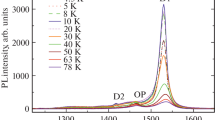Abstract
Generation of dislocations in CdTe crystals induces new lines in the radiative recombination spectra, so-called “dislocation” photoluminescence bands. The spectral distribution of the “dislocation” photoluminescence bands and the spatial distribution profiles of their intensity in the vicinity of the points of indentation on the (111) and (001) faces are obtained. From the comparison of the profiles with the crystallographic structure of dislocations, the types of defects responsible for two groups of emission bands are identified. One of the groups (with the main peak at 841 nm) is controlled by the electron states of 60° dislocations with extra half-planes framed by tellurium atoms, referred to as Te(g) dislocations. The emission lines of the other group (with the peak at 806 nm) correspond to the ordered structures of point defects generated by the steps on the screw segments of dislocation half-loops with the Cd(g) head dislocations.
Similar content being viewed by others
References
H. Nakagava, K. Maeda, and S. Takeuchi, J. Phys. Soc. Jpn. 49, 1909 (1980).
S. V. Lubenets and L. V. Fomenko, Fiz. Tverd. Tela (Leningrad) 33(2), 145 (1989) [Sov. Phys. Solid State 31, 256 (1989)].
N. I. Tarbaev, Yu. Shraĭber, and G. A. Shepel’skiĭ, Fiz. Tverd. Tela (Leningrad) 31(8), 127 (1989) [Sov. Phys. Solid State 31, 1348 (1989)].
H. S. Leipner, J. Schreiber, H. Unievski, and S. Hildebrant, Scanning Microsc. 11, 149 (1998).
J. Schreiber, L. Yuring, H. Unievski, et al., Phys. Status Solidi A 171, 89 (1999).
V. N. Babentsov, S. I. Gorban’, E. A. Sal’kov, and N. I. Tarbaev, Fiz. Tekh. Poluprovodn. (Leningrad) 21, 1724 (1987) [Sov. Phys. Semicond. 21, 1043 (1987)].
C. Diaz-Guerra, U. Pal, P. Fernandes, and J. Piqueras, Phys. Status Solidi A 147, 75 (1995).
A. Orlova and B. Sieber, Acta Metall. 32, 1045 (1984).
E. Hall and J. B. Vander-Sande, J. Am. Ceram. Soc. 61, 417 (1978).
H. Iwanaga, A. Tomizuka, N. Shibata, and M. Mochezuki, J. Cryst. Growth 74, 113 (1986).
N. I. Tarbaev, G. A. Shepel’skiĭ, and E. A. Sal’kov, Pis’ma Zh. Éksp. Teor. Fiz. 66, 639 (1997) [JETP Lett. 66, 675 (1997)].
N. I. Tarbaev and G. A. Shepel’skiĭ, Fiz. Tekh. Poluprovodn. (St. Petersburg) 32, 646 (1998) [Semiconductors 32, 580 (1998)].
Author information
Authors and Affiliations
Additional information
Original Russian Text © N.I. Tarbaev, G.A. Shepel’skii, 2006, published in Fizika i Tekhnika Poluprovodnikov, 2006, Vol. 40, No. 10, pp. 1175–1180.
Rights and permissions
About this article
Cite this article
Tarbaev, N.I., Shepel’skii, G.A. Two series of “dislocation” photoluminescence bands in cadmium telluride crystals. Semiconductors 40, 1145–1150 (2006). https://doi.org/10.1134/S1063782606100046
Received:
Accepted:
Issue Date:
DOI: https://doi.org/10.1134/S1063782606100046




